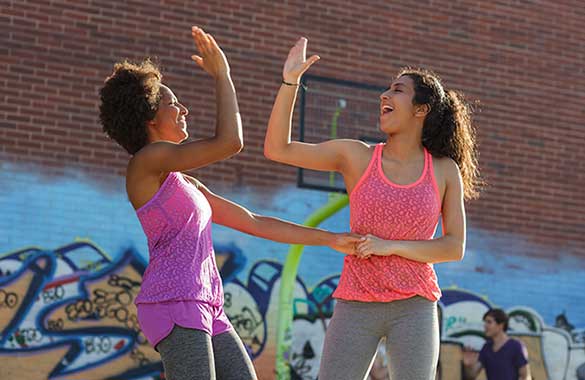
Rewards are powerful motivators for behavior change. Small celebrations—a high-five after a challenging set or an “I nailed it” after completing a difficult challenge, even if that challenge was simply to get up and walk the planned five minutes for the day—create a positive wave of emotion. This positivity makes it more likely the person will repeat the desired behavior in the future.
BJ Fogg popularized this notion with his Tiny Habits program, which follows the simple recipe:
After ________________________, I will _____________________________. Then, celebrate.
With Tiny Habits, a person first attaches or “anchors” a new behavior to an existing routine (like brushing teeth) or event (like receiving a text message). The anchor serves as a reminder to do the new behavior. Second, he or she does the new “tiny behavior,” a very simple, easy-to-do, fully simplified version of the desired behavior (for example, doing one push-up for someone who would like to begin a strength-training program). Third, he or she celebrates immediately.
The celebration is an oft-neglected component of the formula, but arguably the most important.
Why Are Rewards so Important?
It all goes back to basic psychology, specifically the idea of operant conditioning. Behaviors are learned, or enforced, though rewards and punishments. When given a reward for a job well done, a person will continue to strive to do jobs well. On the other hand, take a reward away or punish a person for a behavior and the behavior will eventually stop.
For better or worse, the most powerful and lasting rewards and punishments are the self-driven ones. Too often people are in the mindset of punishment: “I didn’t do the workout I had planned so I am a failure.” Or, “I ate more than I had planned, so I need to pay it back by punishing myself and not eating anything I enjoy for the next week.” But if the focus is changed to recognizing the positive steps a person has taken—“I got up and exercised, even though I didn’t want to. That’s awesome.” Or, “I added fruit to my breakfast and it felt great!”—then new behaviors would come more easily and last longer (hopefully becoming ingrained habits) because it will feel good to do them.
When developing expertise in helping people change behaviors, it is important to learn how to seamlessly integrate the celebration into the program in a way that supports a client’s intrinsic motivation, rather than relying on praise, rewards or supports that are externally based. Help your clients build celebrations into their behavior-change programs with the following examples and tips:
- Use affirmations to acknowledge positive changes. Praise is an externally driven celebration, such as when a trainer says, “I am so proud of how strong you’ve become!” Transition from providing praise to using affirmations, which serve to help increase a clients’ awareness of their successes. For example, when a client is able to increase the amount of weight lifted, affirm the change with a statement such as, “You are really strong today.” Affirmations are a way of “catching” and identifying positive behaviors or changes the client may have overlooked. When the client then notices this as well, he or she feels a sense of success. Top it off with a “high five” and the celebration helps fuel the behaviors that led to the strength gains.
- Teach clients about the importance of the celebration. We often forget to celebrate accomplishments, especially when they are the little behaviors that ultimately add up to a big outcome. But the celebration and the positive emotion that comes from it help to keep the behavior going. Teach clients this and encourage them to identify specific ways they will build the celebration into goal achievement.
- Help clients build in immediate and long-term rewards, not only for achieving goals but also for taking the steps toward achieving a goal. Goal setting is a routine part of fitness and behavior-change programs. Establishing rewards for completing a goal is also common and encouraged. When celebrating the small successes, take it even further to build in positive reinforcement for the small steps that lead up to the “big reward.” For example, a client might start her own “sticker chart,” on which she puts a sticker in a tracking book every time she works out. Once she gets to 20, she gets some predefined celebration. This may trigger thoughts of behavior charts to help shape kids’ behaviors, but this works for adults, too! Many corporate reward programs have built this psychology into their business models. Starbucks, for example, offers up various “points” for purchases. Eventually you “earn” enough to win a free drink. These types of programs work to incentivize repeating a desired behavior. Just remind clients to aim for non-food celebrations and rewards.
- Teach clients to catch and reframe negative self-talk. Negative self-talk frequently sidelines positive behavior change. Help clients become more aware of their own negative self-talk, and teach them to follow up any negative self-talk with a small positive behavior, followed immediately by a celebration. The celebration can be as simple as, “I did this!”
- Engage in positive practice. With this strategy, every time a desirable behavior is completed, the client rewards him or herself with either verbal praise or some tangible item, which helps to maintain the motivation to keep doing the behavior again and again.
Behavior change is rooted in the psychology of understanding how people think and ultimately behave. The psychology is very clear—the celebration is a key ingredient for ongoing and repeated success, and should become a cornerstone of your behavior-change programs.





 by
by 


